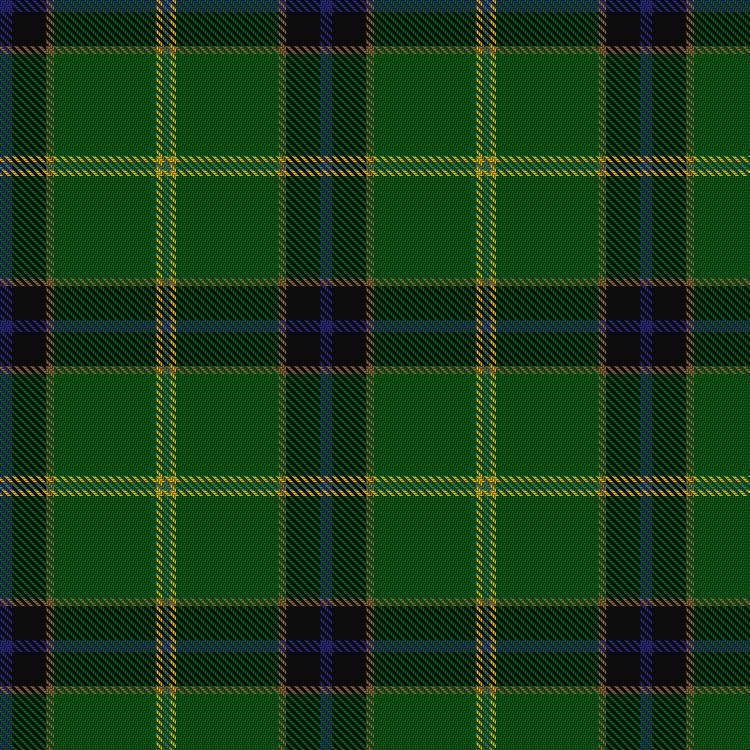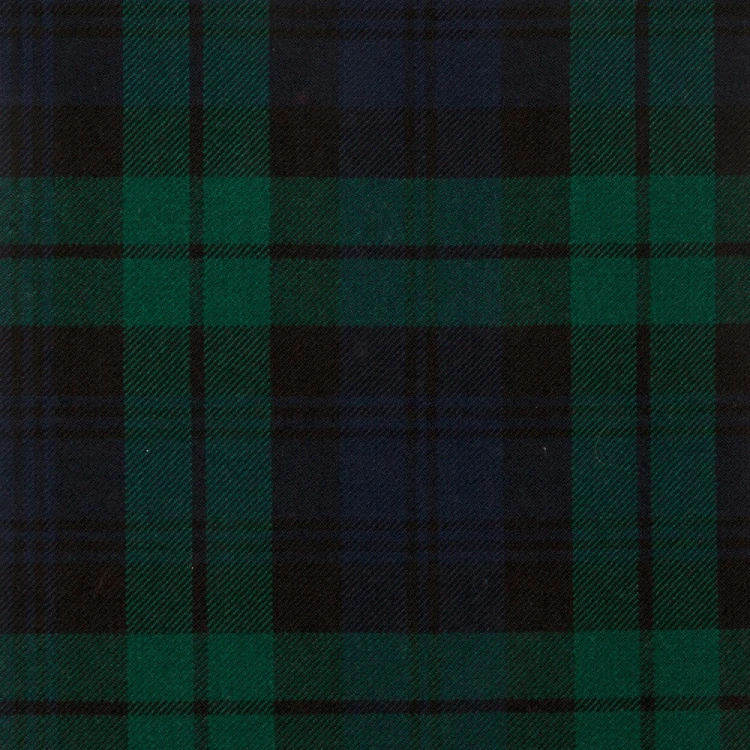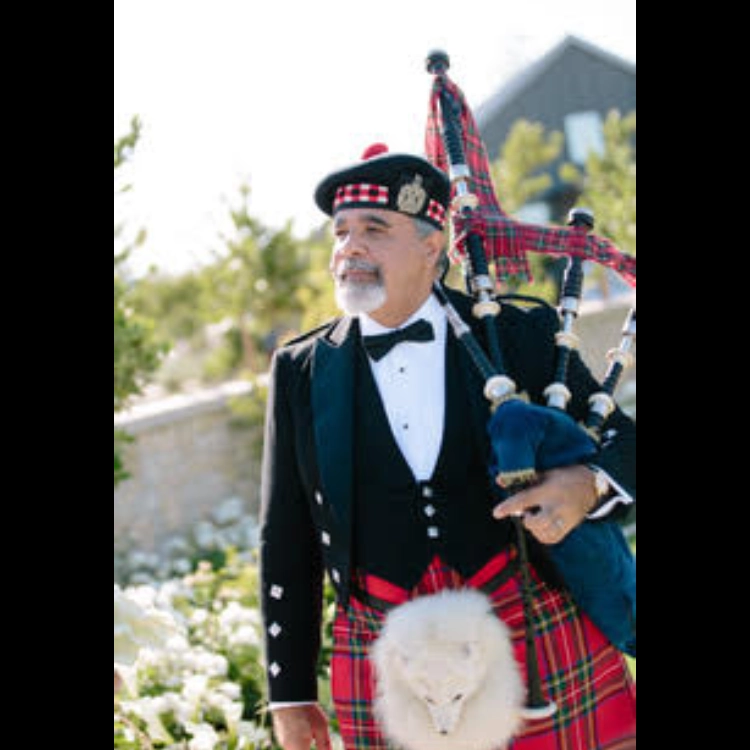Red Royal Stewart Tartan
The Red Royal Stewart tartan is one of the best-known tartan. Previously associated with the Royal House of Stewart, and is also the tartan of the Royal Family. The Scottish Register of Tartans observes that in practice, due to its popularity, it has become a universal tartan, which can be worn by anyone who doesn't have their own clan tartan. "In the same way that clansmen wear the tartan of their chief, it is appropriate for all subjects of the King to wear the Royal Stewart tartan."
Menzies Black and White Tartan
The Menzies Black and White tartan, also called the "Mourning Tartan" was originally the tartan of the Menzies families of the South West Scottish borders - Durisdeer and Enouch. It features a black background with seven white check lines. Although it isn't clear how this tartan became known as a "mourning tartan," it has become the tartan of choice for those who serve the bereaved, as well as a fashionable tartan for elegant formal wear, either for black-tie or white-tie formal events.
Spirit of Scotland Ancient Colors Tartan
The rich purples, blues, and greens hues of the Spirit of Scotland tartan evoke images of Highland heather and Scottish landscapes. The tartan was designed by Michael King in 1998 and is now used by the National Trust for Scotland for Fyvie Castle. The Spirit of Scotland tartan is not related to any Scottish clan and can be worn by all.
United States Army Tartan
The US Army tartan was conceived for use by current members and veterans of the United States Army. Its colors were chosen to represent the various uniforms that the US Army - the largest branch in the US Military - has used: black for the beret, khaki for the summer uniform, light green for the original sniper, and now part of the summer uniform, dark blue for the original dress uniform, olive for the combat uniform and gold for the cavalry.
Raphael Pazo Personal Tartan - Rabbinical
The tartan was conceived by Dr. Raphael Pazo and designed by Mr. Gary James Michael Berreth (OBM) in October 2009. The design is owned by Rabbi Dr Raphael Pazo. Although there are other tartans designed exclusively for clergy, this is the very first tartan registered by the Scottish Register of Tartans that was made exclusively for use by Jewish Rabbis. The Rabbinical Tartan features a rather intricate set (pattern) that employed the use of Ancient Jewish Kabalistic numerology called "Gematria," and the scientific mathematical Fibonacci numerical formulas, and the arrangement of its colors originates in mystical symbolism based on the religious subjects. Each one of the colors of this intricate tartan and the number of threads in each color has religious meanings to Jewish Rabbis, based on the garments worn by the High Priest (Kohen Gadol in Hebrew), who presided over many of the ordinances in the Temple in Jerusalem (Yerushalayim), Israel. The use of this tartan is controlled by Rabbi Dr Raphael Pazo, and its use and wear are restricted to ordained Rabbis in accordance with the Biblical Laws of Sha'aneetz, which enumerate the various restrictions in the manufacture of a garment. This means that the tartan must be woven from 100% virgin wool, certified vegetable dyes, and notarized attestation that none of the labor was performed on Sabbath. The royal blue background of the tartan represents the Priesthood (Rabbinate) that officiated in the Ancient Solomon's Temple in Jerusalem.
Black Watch Tartan
The Black Watch tartan was originally designed and adopted for use by Scottish military units, and it is still worn today by many Scottish Highland Regiments. From the age of the claymore and flintlock to our own era of sophisticated technology, this most elegant tartan has been an enduring symbol of loyalty, courage, and sacrifice.
Tara Murphy Tartan
This tartan is a color modification of MacLean of Duart. This elegant tartan features greens and a green background with brown, white, red, black, and gold lines to form a stunningly elegant tartan suitable for any occasion. Although this tartan bears the name Murphy and is predominantly green, it is not of Irish origin.
A. Semi-Formal - Argyle
This kit is equivalent to wearing a business suit and features a black barathea wool Argyle coat, with or without a wool waistcoat, long tie, shirt, daytime sporran (leather or leather with fur), silver sghian dhub, hose, and brogues. Suitable for most daytime and non-formal evening events. Balmoral or Glengarry bonnet with appropriate hackle is used when outdoors.
B. Formal - Prince Charlie (Black or White Tie)
This kit is equivalent to a tuxedo and features a hand-made kilt, black barathea wool Prince Charlie coat with satin lapels, black waistcoat with satin lapels, pleated or smooth white shirt, white or black bow tie, fur sporran, jeweled sghian dhub, hose, flashes and brogues. Suitable for formal events such as weddings, Burns Suppers, evening Highland gatherings, and other formal events.
C. Formal - Montrose
The Montrose is a formal attire kit that features a tailored black barathea wool jacket with French pointed lace jabot and cuffs, a formal fur sporran, jeweled dirk, and sghian dhub, belt, hose, and brogues. Suitable for formal events such as weddings, Burns Suppers, evening Highland gatherings, and other formal events.
D. Full Military - Number One Kit
This type of uniform is used for highly formal events, including military events, tattoos, parades, concerts, and other special events. This kit is among the finest and most elaborate piper attire options. Due to its complexity and maintenance costs, a premium fee of $175 will be added to the performance fee when using this uniform. Available in Red Royal Stewart, Black Watch, and Rabbinical Tartans only.












